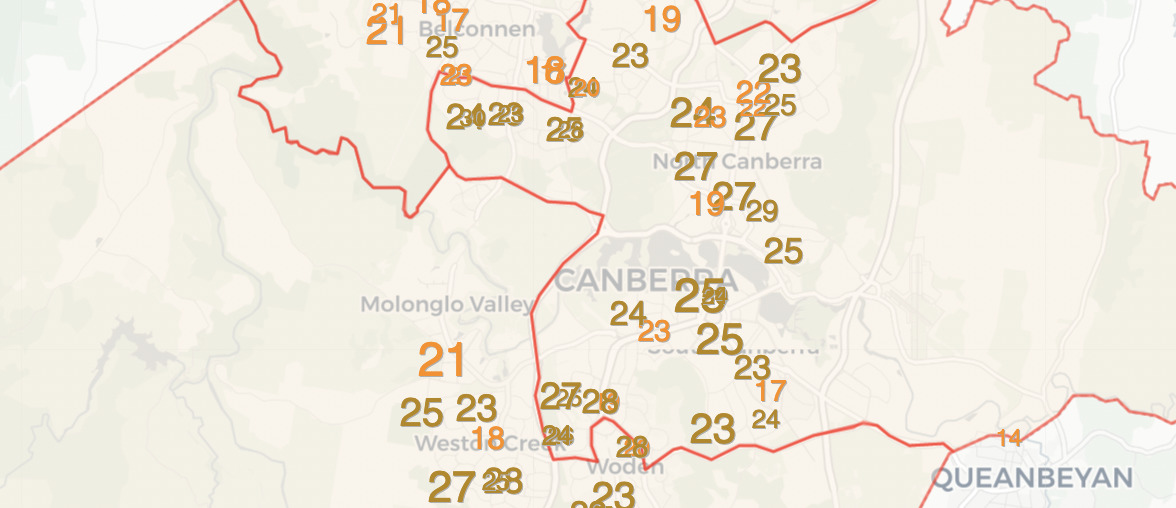Today I’m looking at booth results across the ACT. I’m starting with a two-candidate-preferred map, but probably the Senate race is more interesting, where independent candidate David Pocock polled over 20% and knocked out Liberal senator Zed Seselja.
Starting with the two-candidate-preferred vote, it’s worth noting that the count in Canberra (the central seat) is Labor vs Greens, while the other two seats are Labor vs Liberal. It can be hard to tell because Labor won every booth. Labor’s weakest area is the inner north, where they polled below 60% in most booths.
The next layer shows who won each booth in the Senate race. Labor won almost everywhere, with the Liberals topping the primary vote in a handful of booths in Tuggeranong, Gungahlin and the inner south, and the Greens also topped the city booth for two of three seats. While Labor won most booths, they won it off quite a low vote. I can’t see a single booth where the top-polling party cracked 40%.
The next four layers show the Senate primary vote for Labor, Liberal, Greens and David Pocock.
Labor’s vote was mostly strongest in Belconnen, Gungahlin and the inner north, but was fairly even across the territory.
The Liberal primary vote was highest in Tuggeranong and Gungahlin, regularly cracking 30%, while the Liberal primary vote across most of the inner north was barely in the low teens.
Pocock’s vote was strong in the seat of Canberra, which is unsurprising, but he tended to do better in the south than the north.
The Greens vote was badly reduced thanks to Pocock’s candidacy, but they still polled well into the teens in the inner north, and did better in the outer north than the outer south.
I decided to compare the House and Senate vote to see how much Pocock’s support matched areas of support for the Greens, but found very little relationship. I did find a stronger relationship with Labor’s primary vote.
Actually, though, I want to compare the combined progressive House vote to Pocock, to get a sense of how much of his support has been drawn from the left. We don’t have two-party-preferred data for Canberra, but I compared Pocock’s Senate vote to the combined House vote for Labor and the Greens, and there is some relationship here.
The correlation becomes much weaker if you remove Norfolk Island, a small booth where independent Jamie Christie topped the House primary vote and Kim Rubenstein topped the Senate primary vote.
While this chart does suggest Pocock did better in more progressive parts of Canberra, he also picked up a lot of support in more Liberal areas, consistent with the idea that he also needed to peel away Liberal votes to defeat Seselja.




Progressive vs conservative aside, as a famous football player Pocock would have gained quite a few of the “new” Liberal voters – people who tend to have little or no interest in politics but tend to be avid sports fans.
A number of people had analysis a couple of days ago – there’s enough people who voted Pocock, preferencing Liberal (at least in 4CP terms), that if you exclude Pocock’s ticket, Zed Seselja gets back in.
David Pocock is the Zali Steggall of 2022 – a sportstar turned independent MP who booted out a religious conservative Liberal. I mentioned elsewhere on Tally Room that since ACT is an affluent, progressive electorate, the Libs should preselect a moderate or small-l liberal instead of a religious conservative, like Zed, next time.
Looking at the senate results, the Libs suffered the biggest swing (7.58%) followed by the Greens (7.42%) and then Labor (5.98%). Normally the Greens would win or come close to winning if they were to have a high-profile candidate or strong campaign like in metro Brisbane combined with a pro-Labor, anti-Liberal swing.
I suspect that many loyal Lib voters just couldn’t stomach voting Labor and ending years of loyalty or betraying their Liberal-voting families but were happy to vote for an independent, not just in Canberra but in Sydney, Melbourne and Brisbane.
Quite remarkable there isn’t a single Liberal booth in the ACT anymore. A decade ago there used to be some Liberal strength around the suburb of Deakin.
It’s very impressive how Pocock was able to perform so well across the whole city. His vote was less concentrated to the South than I thought it would be! Thanks for all these posts Ben, they’re quite interesting.
One interesting issue is the extent of tactical voting by Greens and Labor voters between the Reps and the Senate. The other is what happened to the liberal vote in the House of Reps it was down to 26.5% not all that far above their vote in the Senate 24.8% – that suggests that Scott Morrison was seriously on the nose in the Act regardless of how unpopular Zed was
I wonder if it’s possible for the ACT and NT to have more senators in the future. I get thatall states, including Tasmania, should have the same number of senators as per the constitution but both territories combined have a larger population than Tasmania but have 2 senators each. I’m advocating from a democratic and equality point of view because it’s not 1901 anymore.
If ACT/NT were to get 3 or 4 senators each, the minor parties (not the Greens) like UAP, JLN and ON will make a lot of noise because they know their chances of winning are slim and they will feel even more outnumbered when more ALP, LNP, Greens senators get in. However, this may open the door to strong, high-profile independents and locally-based minor parties, who are in with a shot.
@Votante ACT and NT should get 4 senators all up for re-election every election. This way minor parties have a better shot of representation in the seats.
Comments are closed.